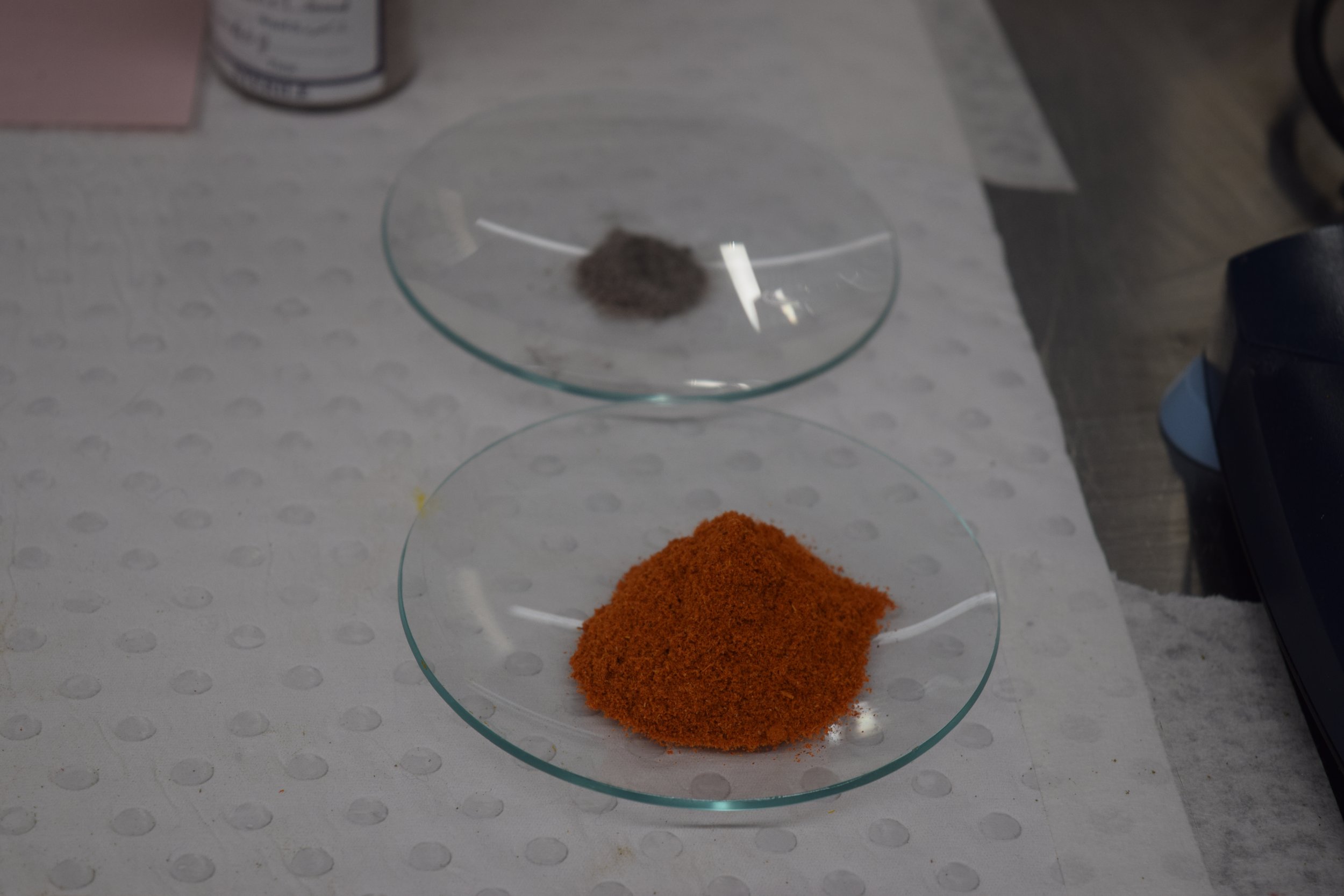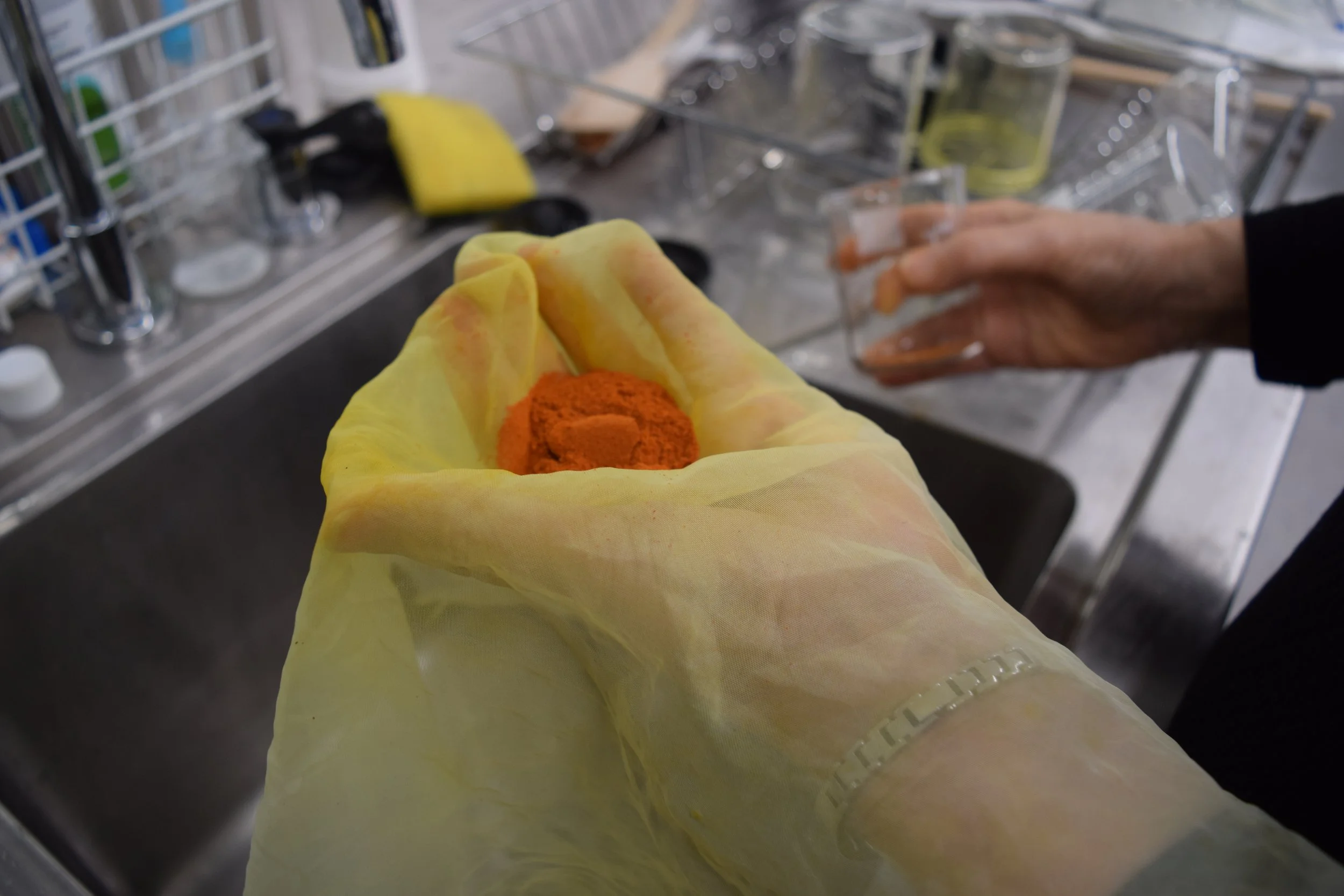ONION RED (PĪĀZĪ), RUBY RED (ARUSAK) AND CHICKPEAS (NOḴODĪ)
All three colours, red onion (pīāzī), ruby red (arusak) and chickpeas (noḵodī) have been described in one recipe in Majmūʿjal-Ṣanāyeʿ (1005 A.H. /1596 A.D) as it is obtained from the process of extracting different shade from safflower:
رنگ کردن عروسک یعنی گل پنبه و معصفر بیارند ازین چندانکه خواهند و او را نیم کوفته در تغاری کند و اندک آب بروی ریزند تا نم گیرد. روز دیگر در یک ذرع کرباس چهارگوشه کند و آب بر وی ریزند تا زردآب بکلّی برود و امتحان به پاره پنبه باید کرد چنانچه سرخ شود و اگر لعل نشود هنوز زردآب دارد همچنان بروانند تا پنبه لعل گردد و آنگاه معصفر را نیک بیفشارند و در آفتاب باز کنند تا نیم خشک شود. آنگاه بگیرند ساجی سوده هر ده سیر را ربع سیر بر وی افشانند و بدست بمالند چندانکه معصفر کشته شود. غایت کشتنی آن باشد که قدری ازین معصفر در قدح آب ریزند و بر سر آب ایستند هنوز کشته نشده و اگر در تک آب نشیند کشته شود. آنگاه در کرباس کنند و بیاویزند و چون اوّل آب بریزند آب اول لعل خواهد آمد. آب اول جدا دارند که این عروس خواهند و مرتبه مرتبه آب ازو گیرند. بعد از آن چون خواهند که کاغذ یا جامه رنگ کنند بیارند آب انار دانهٔ سپید یا آب لیمون یا آب انبلی از اینها هر کدام باشد قدری در آن میان ریزند و دست در آن آب زنند چون کف کند هنوز آب انار کم باشد بیفزایند و چون کف کم شود و آب ایستاده مانده باشد آنگاه بیارند کاغذ سفید همواره سطبر و قالبی در قدری کاغذ رنگ در میان آن قالب کنند و کاغذ در آن رنگ افکنند. ۲) اگر غلظه در غایت سطبری باشد دو پاس بیشتر در رنگ بگذارند و اگر نه یکپاس رنگ عروسک لطیف آید. چون خشک شود مهره کنند پیازی باشد
رنگ نخودی قبل از آن آب انار در میان معصفر ریزند.......... ونخودی باشد رنگ شد آن زردآبی که اوّل از معصفر آمده باشد کاغذ در آن تر کند
To obtain arusak color, safflower and cotton balls are brought. The desired amount of safflower is semi-pounded and placed in a large earthen flower-pot. Water is added until the flowers are moistened. The next day, the flowers are placed in a one-zare’ (approximately one meter) square muslin cloth, and water is poured over until all its yellow bile is extracted. The safflower is then tested by moistening a cotton ball; if it does not turn red, it still contains yellow bile substance. In that case, continue to pour water until the cotton ball turns red when moistened.
At this point, the safflowers are kneaded, squeezed, spread, and left under the sun until they are semi-dried. Then ground alkaline ash (zaj) is brought, and for each 10 sir safflower, ¼ of alkaline ash is sprinkled on safflower and kneaded with fingers until fully mixed. The test to ensure the safflower is mixed properly with alkaline ash is to drop a small part of it into a bowl of water. If some particles float to the surface, the process is not complete; if they settle at the bottom, the safflower is properly mixed with alkaline ash.
The mixture is then placed in the muslin cloth and hung, followed by pouring water over it. The first extract will be red (laʿl), which is reserved for arus (ruby red) color. The pouring of water over the muslin is continued several times to extract different shades of safflower dye. When required to dye paper or cloth, add some pomegranate or tamarind juice to the dye and shake the mixture by hand. If the dye foams, add more pomegranate juice (sour substance) as needed. After removing the foam and settling the dye, papers are brought and dipped in the dye bath. To obtain an elegant red ruby (arusak), one-time soaking is sufficient provided the dye concentration is consistent enough. Onion red (piazi) will be obtained with two soakings in the dye bath. After papers are taken out from the dye bath, they are dried, followed by sizing.
The shade of chickpeas (nokhodi) is obtained from the yellow bile substance extracted initially from safflower …..before pomegranate juice is added.
The process of creating shades from onion Red (pīāzī), ruby red (arusak) and chickpeas (noḵodī) employs the same technique used for obtaining dyes from yellow and red safflower extracts to create different several shades from yellow to red. Chickpeas (noḵodī): Start by taking 5g of safflower petals and grinding them thoroughly with a pestle and mortar or an electric blender. Transfer the ground petals to a muslin cloth, tightly closing it to form a sac. Wash the sac with cold water until all the yellow colorant is extracted. To check, moisten a piece of white cloth with the dye releasing from the sac. If a yellow stain appears, continue the washing process. Conversely, if a red stain is observed, the washing process is complete. Collect the yellow safflower extract for dyeing chickpeas (noḵodī) paper. Ruby red (arusak): After extracting all yellow safflower, then thoroughly squeeze the washed safflower in the sac. Next, transfer the safflower to a mortar and rub it with your fingers. Add 1–2g of alkaline ash to the mortar (the ratio of ground safflower to alkaline ash is approximately 5:1), grinding them together slowly until the red colorant appears. Transfer the mixture back to the muslin sac. Use a pipette to slowly pour warm water over the sac until the safflower dye is extracted. Separate the first superior extract from the second and the last, resulting in three different shades. Pour a small amount of lemon juice about 10 ml. into the red safflower dye. Add lemomn juice gradually as needed. To obtain an red ruby (arusak), one-time soaking the paper is sufficient provided the dye concentration is consistent enough. Dip the paper in the mixture and immediately take it out. Let it dry in the shade. Red (pīāzī): To obtain onion red (piazi) two soakings in the red safflower dye bath is nessary. After the dyebath, take out the paper and let it dry in the shade.
Experiment: The process of creating shades from onion red (pīāzī), ruby red (arusak), and chickpeas (noḵodī) employs the same technique used for obtaining dyes from yellow and red safflower extracts to create different shades from yellow to red.
Chickpeas (noḵodī): Begin by taking 5g of safflower petals and grind them thoroughly with a pestle and mortar or an electric blender. Transfer the ground petals to a muslin cloth, tightly closing it to form a sac. Wash the sac with cold water until all the yellow colorant is extracted. To check, moisten a piece of white cloth with the dye releasing from the sac. If a yellow stain appears, continue the washing process. Conversely, if a red stain is observed, the washing process is complete. Collect the yellow safflower extract for dyeing chickpeas (noḵodī) paper.
Ruby red (arusak): After extracting all yellow safflower, thoroughly squeeze the washed safflower in the sac. Next, transfer the safflower to a mortar and rub it with your fingers. Add 1–2g of alkaline ash to the mortar (the ratio of ground safflower to alkaline ash is approximately 5:1), grinding them together slowly until the red colorant appears. Transfer the mixture back to the muslin sac. Use a pipette to slowly pour warm water over the sac until the safflower dye is extracted. Separate the first superior extract from the second and the last, resulting in three different shades. Pour a small amount of lemon juice, about 10 ml, into the red safflower dye. Add lemon juice gradually as needed. To obtain red ruby (arusak), one-time soaking of the paper is sufficient provided the dye concentration is consistent enough. Dip the paper in the mixture and immediately take it out. Let it dry in the shade.
Red (pīāzī): To obtain onion red (piazi), two soakings in the red safflower dye bath are necessary. After the dyebath, take out the paper and let it dry in the shade.









